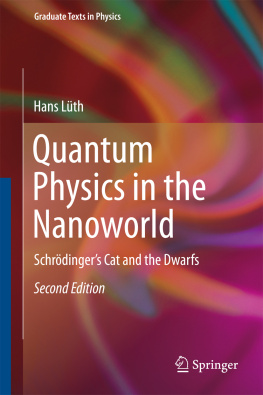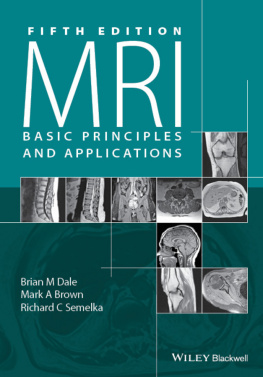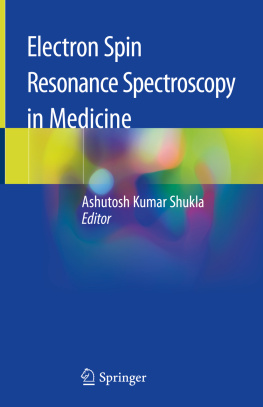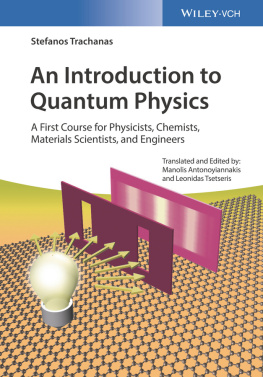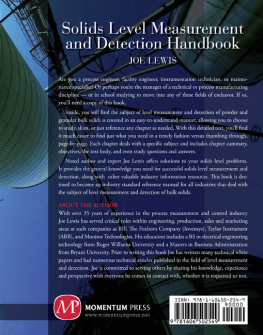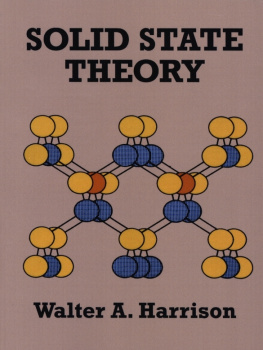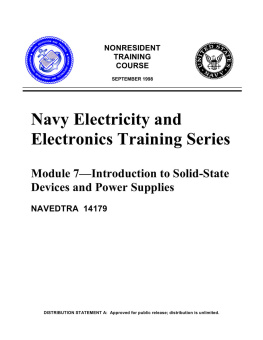SOLID-STATE NMR
SOLID-STATE NMR:
BASIC PRINCIPLES & PRACTICE
DAVID C. APPERLEY, ROBIN K. HARRIS & PAUL HODGKINSON

Solid-State NMR: Basic Principles & Practice
Copyright Momentum Press, LLC, 2012.
All rights reserved. No part of this publication may be reproduced, stored in a retrieval system, or transmitted in any form or by any meanselectronic, mechanical, photocopy, recording, or any otherexcept for brief quotations, not to exceed 400 words, without the prior permission of the publisher.
First published by Momentum Press, LLC
222 East 46th Street, New York, NY 10017
www.momentumpress.net
ISBN-13: 978-1-60650-350-8 (hard back, case bound)
ISBN-10: 1-60650-350-2 (hard back, case bound)
ISBN-13: 978-1-60650-352-2 (e-book)
ISBN-10: 1-60650-352-9 (e-book)
DOI: 10.5643/9781606503522
Cover design by Jonathan Pennell
Interior design by Exeter Premedia Services Private Ltd.,
Chennai, India
10 9 8 7 6 5 4 3 2 1
Printed in the United States of America
CONTENTS
PREFACE
Nuclear magnetic resonance (NMR) has proved to be a uniquely powerful and versatile spectroscopy, and no modern university chemistry department or industrial chemistry laboratory is complete without a suite of NMR spectrometers. The phenomenon of nuclear spin may seem an odd basis for an analytical tool, but it is the relative isolation of the nuclear spin from its surroundings that makes it an ideal noninterfering probe of the electronic environment. Different sites are clearly identified by their chemical shifts, while J couplings in H spectra provide connectivity information. The combination of these two complementary interactions, plus the formidable array of different NMR experiments developed since the arrival of Fourier transform NMR in 1966, has revolutionized the practice of chemistry.
While the original discovery of NMR involved both solids and liquids, the application of NMR to materials in solid form developed at a markedly slower rate than its solution-state counterpart until relatively recently. The most obvious explanation for this difference is the fact that molecular mobility in isotropic solutions averages anisotropic interactions (such as shielding) to their isotropic values. In particular, for solids it is necessary to consider a number of NMR interactions (notably the dipolar and quadrupolar interactions) that can generally be ignored for the solution state. These can significantly reduce spectral resolution and complicate interpretation of spectra. On the other hand, the direct effect of these interactions means that solid-state NMR is potentially a much richer information source than NMR of solutions.
A second, perhaps less appreciated, reason for the relatively tardy progress of solid-state NMR is the nature of the solid state itself. Solids, and especially the samples the solid-state NMR spectroscopist is asked to deal with, are rarely the simple monocrystals beloved by diffraction crystallographers. Solid-state NMR may well give broad, featureless lines for amorphous or heterogeneous samples, but this reflects the underlying nature of the systemthe chemical shift of a given nucleus may be a distribution and not a single value as it would be if the sample were dissolved. As a result, solid-state NMR may be providing too much information, so that the art of solid-state NMR spectroscopy lies in finding the right approach to refining the information content.
It is this complex interaction between the nature of the sample and the multiple anisotropic NMR interactions that makes solid-state NMR a challenging technique to master, and the treatments in undergraduate texts do little to dispel the image of a dark and troublesome technique. The purpose of the current text is to provide a bridge between the familiar world of isolated molecules relevant to solution-state NMR and the subtle world of solid materials. We hope that this introduction and survey will be of value to both established researchers wishing to learn what solid-state NMR can (and cannot) do for their systems and graduate students starting work in this area. We have deliberately avoided detailed mathematical treatments in the early chapters, concentrating on providing that essential qualitative feel for the different aspects of solid-state NMR. The theoretical treatment, which will be of most relevance to those starting a career in the field, is delayed to chapter 4. This survey of the theoretical tools used in solid-state NMR should allow the reader to tackle the more specialized literature with increased confidence. The advanced experiments described in chapters 58 can only be completely understood in terms of the underlying theory, but again a basic feel for the experiments and what information they provide should still be clear without such knowledge.
Solid-state NMR is now too vast and varied to try to present a comprehensive review. Our goal is rather to provide a survey of the technique and the essential tools for exploring further, together with a practical guide on the application and use of solid-state NMR. A selection of review articles is listed at the end of each chapter for those wishing to explore individual topics in more detail. Similarly, to keep the text to a manageable size, we are assuming a basic familiarity with H and C solution-state NMR and the Fourier transform NMR experiment (see the Further reading for chapter 1 for some excellent introductory texts).
We have tried to emphasize the interactions between solid-state NMR and other techniques. A very significant one of these is the cross-fertilization between the solid-state and solution-state branches of NMR. The recent past has seen a proliferation of multidimensional techniques, often initially developed in solution, being applied to solid-state NMR. Solids are intrinsically complex materials and we cannot expect a single technique to provide all the answers, so we also point out where the interpretation of NMR results is aided by other experimental techniques, such as X-ray diffraction, or tools from theoretical chemistry, such as ab initio calculation of chemical shifts. Moreover, we emphasize the additional information (much of it complementary to that obtained by diffraction measurements) that NMR brings to our knowledge of solid-state structure.
In summary, making the best use of solid-state NMR involves a good understanding of the materials under study, familiarity with a broad range of techniques, and a sense for the complementary information that can be provided by other techniques. This may seem a daunting challenge for a newcomer, but the subtle interactions between sample, equipment, and theory are key as to why solid-state NMR is such an intellectually rewarding field in which to work.
Many people have contributed to the appearance of this book. Members of our research group have read and commented on the various chapters as they were written, for which we thank them. We are also very grateful for detailed comments on by Dr. Sharon Ashbrook. A number of research colleagues in other locations have supplied the basis for some of the diagrams, as is acknowledged at appropriate places, and we thank these friends for such help. Finally, we thank our publishers, Momentum Press, for the attractive style and efficient production of the book.
David C. Apperley, Robin K. Harris, Paul Hodgkinson
October 2011, Durham
ABOUT THE AUTHORS
David C. Apperley studied chemistry at the University of East Anglia, Norwich, and gained a Ph.D. for research on dipolar coupling in solids from the Open University, Milton Keynes, in 1986. He further developed his interest in solid-state NMR while working as a senior experimental officer in the Durham Solid-State NMR Research Service, at first in the Industrial Research Laboratories and now in the Department of Chemistry, Durham University. For many years he has been the manager of the facility, which serves both industry and other universities (the latter operation funded by the Engineering and Physical Sciences Research Council). His role with the NMR Service is to provide access to, training in, and interpretation of results from solid-state NMR measurements for scientists in industry and in the UK universities. As well as providing support to organic, organometallic, inorganic, and physical chemists, he specializes in the experimental application of solid-state NMR techniques to characterization or problem solving in a wide range of solid (and sometimes not so solid) materials, including pharmaceuticals, catalysts, ceramics and glasses, polymers (synthetic and natural), soils (and related materials), and household products. He has co-authored 150 publications in the scientific literature.


